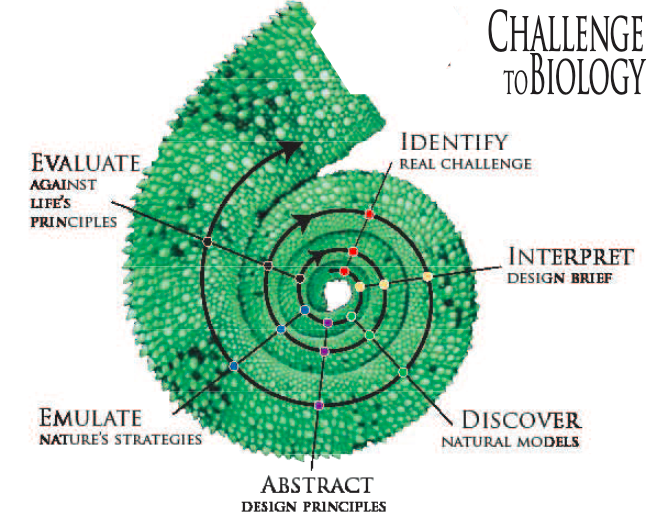Challenge to Biology (C2B) Project
Kelsey Nelsen | Assignment 5.2 | 10.3.2021
Introduction
The Challenge to Biology Spiral
Image Source: The Biomimicry Institute
The Challenge to Biology Spiral is a tool that is used to solve a problem with a nature-inspired solution. The tool encompasses the following steps:
Identify - identify the challenge, what is the intention of this design?
Translate/Interpret - how does nature perform this function? reframe the question. define habitat conditions that reflect design parameters. translate Life’s Principles into design parameters.
Discover - go outside. consider literal and metaphorical models. research. brainstorm with biologists. explore asknature.org.
Abstract - identify strategies used to perform the function. identify patterns and principles. reverse engineer the strategy. describe the strategies using technical terms. create a taxonomy.
Emulate - design! brainstorm using divergent thinking. meet multiple functions. refer back to discover and consider chimera designs. consult with biological experts. go back and explore more.
Evaluate - compare your design against Life’s Principles. does the design adapt & evolve? etc. consider what you have learned. how can the design be improved?
Challenge to Biology
The CHALLENGE: use the C2B spiral to come up with a biomimetic design for a jacket or coat to be worn outdoors, choosing the outdoor conditions for which it is designed with one feature or function as the focus of the design.
Session 1
IDENTIFY
The objective is to design a jacket that provides protection from the sun.
In the summer, I find myself wearing tank tops most days thus relying on sunscreen to protect my skin. Sunscreen is applied to protect the skin from sunburn, however many sunscreens on the market are made of chemicals that can be harmful, especially with repeated use.
Instead of using sunscreen, I’d love to be able to wear a light jacket that not only protects my skin, but keeps me cool and comfortable throughout the hot, humid summers in Minneapolis.
Operating conditions:
provides protection from UV rays
maintain comfortable temperature
moisture wicking
lightweight
stylish
TRANSLATE/INTERPRET
How does nature perform this function?
hair/fur
mineral baths (ie. mud)
sweat
DISCOVER
During hot summer days, many animals take shelter from the sun to protect their skin and keep cool in the shade provided by plant life. What is it about plants that provides protection for their own leaves and also all the animals that may be susceptible to UV rays?
Image Source: AskNature.org
Animals like hippopotamuses (https://asknature.org/strategy/secretion-protects-skin/#.WIn8tvkrKUk) also seek cover with mud and sometimes are able to secrete a sweat-like substance that also has properties that can protect the skin from the sun.
The calcium carbonate in the exoskeletons of ocean coral can protect them from harmful UVR light (https://asknature.org/strategy/exoskeleton-absorbs-uv-light/).
A red carotenoid pigment in snow algae helps protect from UV light and maintain liquids in extremely cold temps (https://asknature.org/strategy/red-pigment-protects-against-uv-rays/).
Fungal skin protects lichen from harmful UV rays (https://asknature.org/strategy/fungus-provides-uv-protection/) .
ABSTRACT
Strategies
reflecting properties can be useful in decreasing sun damage
the color “red” and red pigment 2 protect against UV rays
melanin protects skin from sun damage
material choices are vital
EMULATE
This design will have the following functions:
contain red carotenoid pigment 2 to absorb UV light
reflect rays to maintain comfortable temperature
EVALUATE
The design as it relates to Life’s Principles:
Cyclic processes
This design will respond to and reflect UV light
Optimize vs. maximize
This design has multiple functions (UV protection, thermoregulation)
It may be worn while participating in physical activity, or as an outfit staple
Benign manufacturing
Ideally this design would be made from natural fibers and pigments, more research will need to be done before confirming feasibility.
Session 2
IDENTIFY
The objective is to design a jacket that provides protection from the sun, but also function to provide breathability and thermoregulation. How can this jacket offer more functionality?
TRANSLATE/INTERPRET
How can this jacket leverage feedback loops for temperature regulation? Explore the characteristics of animals and plants exposed to sunlight and changing environmental conditions.
DISCOVER
Image Source: Rob Pumphrey via Unsplash
Thatched shelter of nest maintains temperature and humidity (https://asknature.org/strategy/colonies-maintain-temperature-and-humidity/)
The sweat glands and fur coat of camels allow them to keep cool (https://asknature.org/strategy/how-a-camels-fur-coat-keeps-it-cool/)
ABSTRACT
Strategies
fabric weave will allow for breathability
EMULATE
This design will have the following functions
there will be points of ventilation that will encourage greater airflow under certain conditions
the user will manually adjust these vents when needed
the material will be moisture-wicking
EVALUATE
The design as it relates to Life’s Principles:
Cyclic Processes
Leverages feedback loops based on both internal and external temperature and humidity
Resilient
This design is capable of functioning in primarily sunny weather, but responds to both hot and cold temperatures.
Session 3
IDENTIFY
How can this jacket be useful across seasons and landscapes?
TRANSLATE/INTERPRET
Image Source: AskNature.org
To add more functionality, this jacket should also perform some element of energy storage for warmth when the sun goes down. Consider plants and animals that are successful in creating their own stored solar energy.
DISCOVER
Protein turns sunlight into color: (https://asknature.org/strategy/protein-turns-sunlight-into-vivid-color/).
Pigments absorb solar energy: (https://asknature.org/strategy/pigments-absorb-solar-energy/).
ABSTRACT
Strategies
harvesting solar energy for storage
EMULATE
This design will have the following functions
the use of pigments will harvest solar energy to be converted to heat after sundown
cooler air will trigger release of stored energy in the form of heat
EVALUATE
The design as it relates to Life’s Principles:
Locally Attuned & Responsive
The design will take into account temperature, moisture, UV light, and energy stores
It utilizes free local energy in the form of sunlight
Cyclic Processes
Leverages feedback loops based on both internal and external temperature
Interdependence in the System
By regulating heat, this design aids in conditions conducive to life
Final Jacket Design
Offered here both as a long or cropped version:




